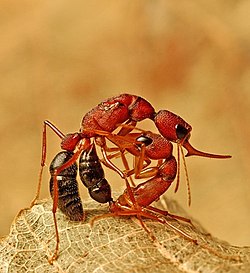| Ponerini | |
|---|---|
 | |
| Fighting Harpegnathos saltator | |
| Scientific classification | |
| Kingdom: | Animalia |
| Phylum: | Arthropoda |
| Class: | Insecta |
| Order: | Hymenoptera |
| Family: | Formicidae |
| Subfamily: | Ponerinae |
| Tribe: | Ponerini Lepeletier de Saint-Fargeau, 1835 |
| Genera | |
See text | |
| Diversity | |
| 46 genera 6 extinct genera | |
Ponerini is a tribe of ponerine ants with 46 genera and 6 extinct genera. [1] It contains every ponerine genus except Platythyrea , which is placed in its own tribe Platythyreini. [2]